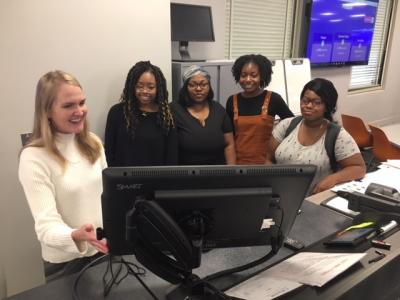Quality Enhancement Plan for Core Course in History Focuses on Student Success
Wed, 02/27/2019 - 03:38pm

Three years ago, University of Southern Mississippi (USM) faculty members teaching select core courses embarked on a major effort to strengthen student success and student learning as part of the University Quality Enhancement Plan, or QEP, a component of accreditation by the Southern Association of Colleges and Schools Commission on Colleges.
Successful completion of core undergraduate courses in the humanities, math, and sciences is required to earn a degree at USM, and at 4-year colleges and universities across this state and the nation. The principal behind this is to ensure that no matter what students major in, they are broadly trained to be successful decision makers in the complex world in which they work and live.
To achieve this goal, teams of faculty members across USM met to determine what steps
could be taken to improve student outcomes while maintaining a commitment to academic
rigor and standards. They believe the plan in place maximizes opportunities for success
in these courses through the design of instruction delivery models that adapt to a
variety of student learning styles, while minimizing challenges hindering positive
outcomes.
Work began at USM in spring 2016 on this initiative by fundamentally changing the
way several key courses were taught. Faculty members participated in a review of data
and key performance indicators guided by the John N. Gardner Institute Gateway to
Completion process. From there, Gateway Committees developed plans to create different
learning formats that recognized the diverse learning styles of our students to help
them successfully complete core university courses.
One example of these reforms is found in the history course “HIS 101: World Civilizations to 1500.” Southern Miss history faculty members recognized that some students are succeeding in larger groups taught by scholars such as Dr. Heather Stur and Dr. Andy Wiest. Others, though, need more assistance with history and tend to thrive in the smaller, active learning sections offered by Dr. Max Grivno where, as one student observed, “discussions kept me focused,” while another reported that this was the “first time I've enjoyed and was confident about passing a history class.”
History faculty also created a version of HIS 101 offered by Dr. Rebecca Tuuri, Dr. Courtney Luckhardt, or Dr. Susannah Ural that incorporated discussion with the traditional lecture format, allowing 180-student classrooms to work in smaller groups to think deeply about the material covered in readings and lecture. This ensured students were truly understanding the material, and were able to connect it to similar patterns in today's world.
Since starting the reforms, approximately 70 percent of students enrolled in HIS 101 are regularly earning grades of A, B, or C, and these success rates are even higher in some individual sections. “HIS 102: World Civilizations since 1500” sections have implemented some of these learning formats, too, and success rates have improved from 2014-15 to 2018. Given that 1,400-1,600 students take these courses each year, the impact is far-reaching.
According to Dr. Ural, chair of the History Gateway Committee, the biggest goal of the reforms is to improve student learning in HIS 101 and she's pleased with the success achieved so far, but her colleagues also wanted to create different learning environments that met the diverse educational needs of all USM students.
“If big auditorium sections with some of our most popular faculty work with some students, let's not change that. But for those who need more one-on-one attention, we wanted to make that available,” Dr. Ural said. “This approach has allowed thousands of students to develop the skills they need to succeed not just in HIS 101 or HIS 102, but throughout their time [in other courses] at Southern Miss, and in their future careers.”
Dr. Julie Howdeshell, director of the quality enhancement plan, said she's extremely pleased with the progress made to date and wants the trend to continue.
“I have often been asked what our target number is for success, and from the beginning I have been intentional in not setting one, instead seeking continuous improvement where we have data and evidence to inform change,” Dr. Howdeshell said. “We're already examining other factors, including advising and placement, to further support student success while ensuring that academic rigor is maintained.
“I'm grateful for the faculty members who have been willing to take risks and make changes, and for the staff who have provided support through data analysis, development of classroom space, and coordination of support. Our students and our university all benefit.”
Learn more about the Southern Miss History Program at www.usm.edu/history.